Herons
The first gallery displays photos of Herons that belong to Ardeidae (Herons, Bitterns and Egrets), see Taxonomy below. I photographed these mainly in temperate and tropical wetlands, including swamps, lakes, and parks. This page also features photo essays of purple, grey and striated herons together with an image gallery of other species depicting feeding, hunting and other behaviours.
Herons
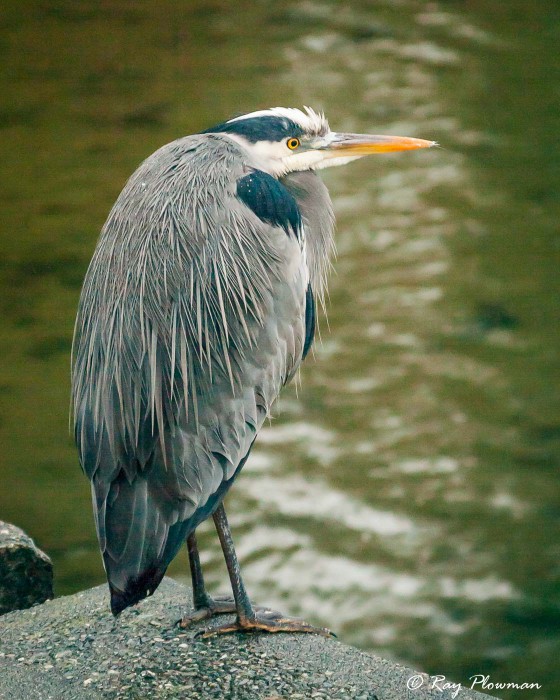
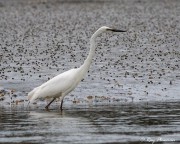
![Intermediate Egret [Plumed] (Ardea intermedia plumifera) perched on the riverbank at Yellow Water Region in Northern Territories Intermediate Egret [Plumed] (Ardea intermedia plumifera) perched on the riverbank at Yellow Water Region in Northern Territories](https://rayplowman.co.uk/wp-content/uploads/2018/09/Intermediate-Egret-Plumed-5640-560x700.jpg)
![Nankeen Night Heron [Rufous] (Nycticorax caledonicus australasiae) Juvenile at Yellow Water Region in Northern Territories Nankeen Night Heron [Rufous] (Nycticorax caledonicus australasiae) Juvenile at Yellow Water Region in Northern Territories](https://rayplowman.co.uk/wp-content/uploads/2018/09/Nankeen-Night-Heron-Rufous-Immature-5224-180x144.jpg)
![Nankeen Night Heron [Rufous] (Nycticorax caledonicus australasiae) perched in mangroves at Yellow Water Region in Northern Territories Nankeen Night Heron [Rufous] (Nycticorax caledonicus australasiae) perched in mangroves at Yellow Water Region in Northern Territories](https://rayplowman.co.uk/wp-content/uploads/2018/09/Nankeen-Night-Heron-Rufous-5773-180x144.jpg)
Heron Notes
All featured species are ‘Red List 2019’ assessed as ‘Least Concern’. The heron family of birds range from medium to large, have long legs and necks relative to their bodies. Their toes are particularly long helping them wade in mudflats or support on vegetation. They prey on most aquatic food such as fish crustaceans, reptiles, amphibians, and insects. Some species are specialist hunters while others feed on a variety of animals and are often opportunists.
Herons are not generally sexual dimorphic although some species do exhibit size dimorphism with males being slightly bigger than females. Some species also occur in colour variations; light and dark morphs, the Great Blue Heron and and Pacific Reef Heron displayed in the gallery are dark morphs. Both the Pied Heron and Nankeen Night Heron [Rufous] feature adult and immature birds. As well as nominate species, many of the images are subspecies in the region where photographed.
Grey Herons (Ardea cinerea) have an extensive distribution being a native resident in large parts of Europe, Africa, and Asia. Two displayed subspecies: A.c. jouyi a resident Singapore bird that has black streaks on the neck and some black on the wings, this distinguishes it from the nominate species Ardea cinerea found in Europe. The image of the nominate species Ardea cinerea shown on a rocky shore Seychelles.
The young adult Black-crowned Night Herons still a has a few juvenile feathers its bill is deformed. Most photos in the gallery are species that I photographed in the topics.
Green, Striated and Lava Herons
Green, Striated and Lava Heron Notes
Three species of Butorides featured in the gallery: Green Herons (Butorides virescens), Striated Heron (Butorides striata) and the Galapagos Lava Heron (Butorides sundevalli) a Galapagos species endemic.
Green Herons have a range through the tropical regions of north and south in America. The Striated Heron distribution is south of Panama through South American the Old World, while the Lava Heron distribution is the Galapagos Islands.
The gallery includes images of four sub-species of Striated Heron: the nominate species in Trinidad; ssp degens in Seychelles, ssp javanica in Singapore; and two ssp sundevalli light-grey and dark morphs in the Galapagos. Two other morph images include a rufous nominate species in Trinidad and a rufous ssp javanica in Mauritius.
I have captioned the Galapagos immature and juvenile images by the collective name Green-backed Heron (B. s.). I’m not sure if they are Lava or Striated Herons. The juvenile has a black cap with yellow-orange lores, probably making it a Striated Heron. The immature is much darker also with yellow-lore possibly making it a Lava Heron, but I haven’t ruled out a Striated Heron. By contrast, both images of the adult Lava Herons show individuals that lack yellow-lores. Both my field guides show images of Lava Herons that do not have yellow-lores and Striated Herons with yellow-lores. The variation in this species is complex and not well understood with polymorphism and hybridisation, contributing to the confusion.
Photo Essay of Purple Heron Behaviour
Purple Heron Behaviour Notes
The photo essay shows a Purple Heron flying to and landing in the main lake in the Japanese Gardens in Singapore. Two short sequences show a heron hunting and stabbing fish and then devouring its prey. The immature was photographed in Bishan Ang Mo Kio park also in Singapore.
Photo Essay of Grey Heron Behaviour
Grey Heron Behaviour Notes
A photo essay of grey herons photographed in Singapore and features:
(a) A sequence of five images at Japanese Garden main lake showing a bird having stabbed a huge fish attempting to swallow it. It took several minutes and needed some water lubrication to help it slide down,
(b) Three images at the tea garden lake of a bird stabbing, manipulating and then perched ready to devour its prey,
(c) And a couple of individuals flying; one at Sungei Buloh Wetland Reserve and the other landing at the Japanese Garden main lake.
Photo Essay of Striated Heron Behaviour
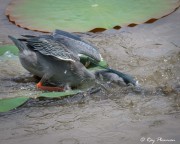
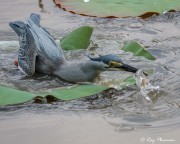
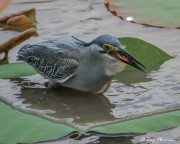
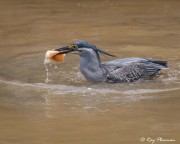
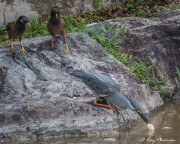
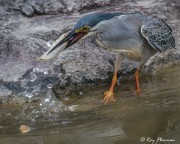
Striated Heron Behaviour Notes
Striated Herons often seen perched near water looking for prey. In Singapore’s Japanese Garden main lake, I observed one individual hunting from lily pads. The bird would stand close to a lily pad edge watching and when a fish came in range would strike either stabbing or catching the fish in its bill. If the fish were small, it would devour it and then go on fishing; otherwise, it would head to the bank to eat it there. Kids and some adults feed the fish with bread. I watched one enterprising bird fly down to the food and bring it back to the bank, then drop it within striking range. It seemed to be a successful technique as it was catching large fish. Common Mynas would take advantage by trying to steal the food.
A final couple of images show ssp degens successfully hunting on the exposed coral rocks at Anse Bazarca in Seychelles. The bird was taking advantage of small fish brought in on an incoming tide but had to avoid the breakers often flying to avoid getting wet.
Two subspecies feature in the gallery, Butorides striata javanica in Singapore and B.S. degens in Seychelles.
Heron Behaviour
![Nankeen Night Heron [Rufous] (Nycticorax caledonicus australasiae) in mangrove shallows at Kakadu National Park Nankeen Night Heron [Rufous] (Nycticorax caledonicus australasiae) in mangrove shallows at Kakadu National Park](https://rayplowman.co.uk/wp-content/uploads/2018/09/Nankeen-Night-Heron-Rufous-5610-560x700.jpg)
![Nankeen Night Heron [Rufous] (Nycticorax caledonicus australasiae) Immature at Yellow Water in Northern Territories Nankeen Night Heron [Rufous] (Nycticorax caledonicus australasiae) Immature at Yellow Water in Northern Territories](https://rayplowman.co.uk/wp-content/uploads/2018/09/Nankeen-Night-heron-Immature-5219-180x144.jpg)
![Nankeen Night Heron [Rufous] (Nycticorax caledonicus australasiae) on the river bank at Yellow Water Nankeen Night Heron [Rufous] (Nycticorax caledonicus australasiae) on the river bank at Yellow Water](https://rayplowman.co.uk/wp-content/uploads/2018/09/Nankeen-Night-Heron-Rufous-6048-560x700.jpg)
![Intermediate Egret [Plumed] (Ardea intermedia plumifera) watching for prey at Hastings Swamp in Queensland Intermediate Egret [Plumed] (Ardea intermedia plumifera) watching for prey at Hastings Swamp in Queensland](https://rayplowman.co.uk/wp-content/uploads/2018/09/Intermediate-Egret-Plumed-_7D_8398ai-560x700.jpg)
Heron Behaviour Notes
The first image in the final gallery shows a Nankeen Night Heron [Rufous] from the Nycticorax genus photographed in golden light as the sun was setting at Yellow Water in Kakadu National Park. Other images feature an adult and an immature bird; Intermediate Egret [Plumed], from the Ardea genus, shown breeding and non-breeding plumage. The final few photos show a Great Egret preening and flying and a Great-billed Heron swallowing a fish, albeit from a distance.
Heron Taxonomy
The Core Waterbirds Webpage describes the higher-level taxonomy for the Ardeidae (Herons, Bitterns and Egrets), in Ardeiformes order, part of the Aequornithes (Core Waterbirds) clade.
Two photo albums feature the Ardeidae (Herons, Egrets and Bitterns) family. This album displays four groups: (i) Genera Ardea (Herons), (ii) Butorides (Green/Striated Herons) (iii) Genus Ardeola (Pond Herons) and (iv) subfamily Nycticoracinae (Night Herons). Genera Ardea (Herons) include the Great Egret and Intermediate Egret. Genera Egretta (Egrets) feature in the Bitterns and Egrets album.
There are Proposed changes to split Cattle Egret (Bubulcus ibis) into Western Cattle Egret (Bubulcus coromandus), and Eastern Cattle Egret (Bubulcus ibis), IOC and J Boyd checklists refer. Most other authorities do not accept the change.

















































![Intermediate Egret [Plumed] (Ardea intermedia plumifera) hunting on the riverbank at Kakadu’s Yellow Water Wetlands in Northern Territories Intermediate Egret [Plumed] (Ardea intermedia plumifera) hunting on the riverbank at Kakadu’s Yellow Water Wetlands in Northern Territories](https://rayplowman.co.uk/wp-content/uploads/2018/09/Intermediate-Egret-Plumed-9449-560x700.jpg)


